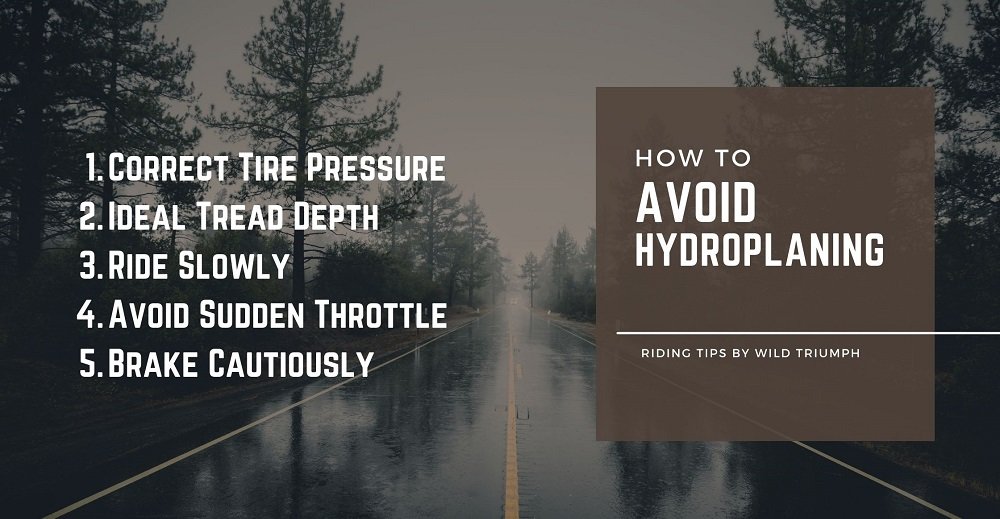What is motorcycle hydroplaning and how to avoid it?
Updated on | By Mohit Chauhan

Have you ever wondered why your motorcycle tires skid on the wet road?
Even if you were able to balance your bike somehow, you most likely experienced hydroplaning for few seconds.
Hydroplaning, also known as aquaplaning is a very common phenomenon that occurs while riding in wet conditions. It is very dangerous and can cause accidents, and deaths in worse cases. To avoid any kind of jeopardy, it is important to know what it is and what to do in case it happens with your motorcycle.
The devious thing about hydroplaning is that it occurs spontaneously. This creates a sense of panic that further aggravates the situation. The tires may lose grip completely and you may end up on the opposite side of the street.
In order to prevent aquaplaning, there are some rules of behavior and factors that have an influence on riding dynamics. In today’s blog we will explain how to react when the motorcycle starts skidding and how to counteract hydroplaning.
What is hydroplaning?
Hydroplaning or aquaplaning is known as floating of the tire over the surface of wet road. Just like ice, water also creates a layer between the tire and the surface of the road, this considerably reduces the friction between the two and causes skid.
In other words, hydroplaning is the phenomenon when water gets retained in the front of the tire and creates a layer of thin film which reduces the friction between the ground and the rubber tire.
If the amount of water is large enough, the friction between the tire and the ground is no longer sufficient to maintain the grip and causes the bike to slip. In normal circumstances, hydroplaning is rare since there is always some amount of friction between the tires and the ground. However, in case of heavy rain, there is a possibility that the tires might get completely lifted from the ground due to the sudden gush of water beneath it. This will surely cause your motorcycle to hydroplane.
Can a motorcycle hydroplane?
In motorcycles, hydroplaning usually only starts at a slightly higher speed because their wheels are very big compared to other vehicles. Nevertheless, motorcyclists should adapt their riding style to the rainy conditions at an early stage, as a greasy film often forms on the road, which can lead to falls, especially while cornering.
Besides, the consequences of losing contact with the road surface are usually more dangerous for a motorcyclist. It is therefore important to drive at a slow speed on wet roads and especially if there is a risk of hydroplaning.
What causes hydroplaning?
The primary task of treads around the motorcycle tires (especially on summer tires) is to divert water that is on the road to the sides and to the rear. However, if the threshold to drain the water is reached, the treads can no longer perform ideally. This usually happens during heavy rainfall when the streets are flooded with water. This excess water then creates a layer between the rubber tire and the surface of the road which results in hydroplaning. Subsequently, the tire is lifted from the ground and the rider can no longer steer or brake.
Hydroplaning can occur both on front as well as rear tire. The risk is particularly high in rain showers after a long period of drought, as oils that accumulate on the road mix with the water to create a more slippery layer.
There is a particular risk of hydroplaning when very heavy rainfall occurs in a short amount of time. This causes the drainage to overflow, which usually gushes towards the road in large quantities. Added to this are potholes that further aggravate the situation; since these potholes hold large quantities of water which causes hydroplaning and accidents if ignored.
How to reduce the risk of hydroplaning
Check the condition of your tires
The more worn your tires are, the higher the risk of hydroplaning. A good tire tread, on the other hand, helps to divert road water. In order to retain the grip, tires usually collect the water from the surface and drain it off using their grooves. So the deeper the tire tread, the better, because the volume of the grooves between the tread blocks is determined directly by the tread depth. If the depth of tread is low, it will considerably increase the risk of hydroplaning. It is therefore necessary to inspect your tires regularly and replace them as soon as you observe a low tread depth.
Ride at moderate speed
Riding in the rain can be tricky, it is important that you ride slowly in wet conditions. If you ride at high speed, the amount of water that gushes towards the tire increases. This causes your tire to drain more water from the grooves until it reaches a threshold level, post which, the treads will not perform ideally. In extreme cases, the tires completely lose contact with the road.
Check the tire pressure
If the tire pressure is too low, hydroplaning may occur more frequently since the surface area of tires increases, which results in poor drainage of water from the treads. Similarly, if the tire pressure is too high, the tires wear unevenly and lose traction. That is why you should check the tire pressure regularly.
Ride proactively
If the road surface is wet, you should ride slowly and at a significant distance from other vehicles. It is important to focus on the road and keep an eye on potholes and trenches where water usually clogs more. Additionally, it is important to check the level of water on the surface of the road, it is best to wait till water subsides before riding again.
What to do if my motorcycle hydroplanes?
Hydroplaning can occur suddenly and can lead to dangerous situations. It is therefore important to prepare yourself beforehand in case you encounter this condition.
When a bike skids due to hydroplaning, your reflexes generally respond in the way you have prepared yourself. Therefore it is important to always keep these things in mind.
Step 1: Hold the steering handle with both hands.
Step 2: Release the throttle slowly.
Step 3: Let the speed of the bike decrease gradually.
Step 4: Engage the clutch.
Step 5: Start applying brakes to gradually reduce the speed.
Step 6: Once your bike is at a reduced speed, you can halt and inspect your tires.
Step 7: If the treads are good and your tire is in good condition, then hydroplaning occurred due to high speed.
Step 8: You can restart your journey at a low speed or wait till the water level recedes.
Will ABS protect my motorcycle from hydroplaning?
There are a number of myths surrounding hydroplaning, among which ABS is by far the most common one. If you think that any kind of ABS will prevent your motorcycle from hydroplaning, then you are completely wrong. When your motorcycle is affected by hydroplaning, the tires lose their contact with the surface of the road. ABS which is primarily dependent on friction to reduce the speed of the motorcycle becomes totally inefficient in this case.
Which tires are least susceptible to hydroplaning?
In order to ensure contact between the tread of the tire and the ground, the water must be absorbed in the tread grooves and drained away again. The volume of the grooves between the tread blocks is directly dependent on the tread depth. As the tread depth decreases, the aquaplaning properties of the tires deteriorate. Studies have shown that with tread depths of around 3 mm and less, aquaplaning can occur even on slightly damp roads.
The parameters that resist towards hydroplaning are primarily associated with the treads of the tires. However, not all types of treads perform equally; symmetrical and asymmetrical treads generally offer high directional stability and excellent handling, but they are not very ideal under wet conditions. Directional treads, on the other hand provide highest protection against hydroplaning and a strong grip at high speed.
Tips for avoiding hydroplaning in the rain
For a motorcyclist safety comes first, and even if you are riding with your helmet and protective gears, there are chances you might get injured. Besides, an accident involves the loss of property as well, and should be avoided in any circumstances. In order to be safe while riding in the rain, there are certain things that should always be kept in mind.
- Ensure that your helmet visor is clean. Rain usually causes the helmet visor to condensate, thus hampering the field of vision. There are many ways to prevent your helmet from fogging, make sure you keep them in mind.
- Functioning headlights increases your safety in rain and hydroplaning: It is best to replace broken bulbs as soon as possible.
- When riding in rain, it is best to switch on the lights. This will increase your visibility and your field of vision. This will give you extra reaction time in case your motorcycle hydroplanes.
- While cornering ensure a constant low speed. An abrupt speed around the corners causes your tires to loose their grip.
- There is no shame in parking your bike at the side of the road in case of heavy downpour. In fact, it is a wise decision to wait for some time till heavy water clogging subsides.
- Do not ride through deep waters; the water on the road should not reach the bottom of your boot.
- If you can’t see the ground underneath the water, chances are there is a pothole or the water is too deep. Look for an alternative route, or wait for a four wheeler to pass first.
- Always check your tires, it is recommended that the tire tread depth should not be lower than 3 mm.
Bottom Line
Most motorcyclists dream of riding on a dry and smooth curvy road with wind gushing towards their face. Unfortunately, the reality in our part of the world looks very different. Because you can neither change the weather nor the nature of smoothness on the road.
Experienced bikers are well aware that, especially after a long period of dryness, a sudden downpour can leave a slippery film of oil on the road surface. This layer has a low coefficient of friction that quickly leads to hydroplaning and, in the worst case, loss of control of the bike.
In addition, the road markings as well as the manhole covers repeatedly prove to be a cause of skid. That is why it is better to adapt your riding style in such weather and avoid risks while cornering.
You may have heard that cars are more frequently affected by hydroplaning; however, aquaplaning in motorcycles is common too. Besides, this phenomenon is more dependent on external factors like, condition of the road surface, the tread depth of the tire and the vehicle speed. Therefore, the most important thing to avoid hydroplaning is to reduce your speed when you are riding under these conditions.
Lastly, a motorcyclist cannot hold the federal government, the state or the municipality liable for an accident that occurs as a result of hydroplaning. Insurance coverage may be void in the event of an accident due to hydroplaning if the motorcycle tires do not correspond to the legal tread depth (U.S Law requires tires to have at least 2/32 inch of tread depth).
Ride Safe!






